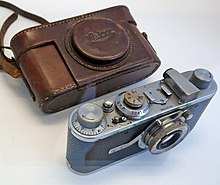Street photography
This article includes a list of references, related reading, or external links, but its sources remain unclear because it lacks inline citations. (December 2009) |


Street photography is a type of documentary photography that features subjects in candid situations within public places such as streets, parks, beaches, malls, political conventions and other settings.
Street photography uses the techniques of straight photography in that it shows a pure vision of something, like holding up a mirror to society. Street photography often tends to be ironic and can be distanced from its subject matter, and often concentrates on a single human moment, caught at a decisive or poignant moment. On the other hand, much street photography takes the opposite approach and provides a very literal and extremely personal rendering of the subject matter, giving the audience a more visceral experience of walks of life they might only be passingly familiar with. In the 20th century, street photographers have provided an exemplary and detailed record of street culture in Europe and North America, and elsewhere to a somewhat lesser extent.
Many classic works of street photography were created in the period between roughly 1890 and 1975 and coincided with the introduction of portable cameras, especially small 35mm, rangefinder cameras, most famously the Leica, as used by Henri Cartier-Bresson, among others.
Technique
Most kinds of portable camera are used for street photography, for example rangefinders, digital and 35mm SLRs, point-and-shoot cameras and smartphones. A commonly used focusing technique is zone focusing — setting a fixed focal distance and shooting from that distance — as an alternative to autofocus, particularly using wide angle lenses with their increased depth of field. Zone focusing facilitates shooting "from the hip" i.e. without bringing the camera up to the eye.[1][2] Alternatively, waist-level finders allow for composing the shot and/or adjusting focus without bringing attention to the photographer.
Notable street photographers
Classic practitioners of street photography include Brassaï, Henri Cartier-Bresson, Robert Doisneau, Alfred Eisenstaedt, Robert Frank, Bruce Gilden, Willy Ronis, W. Eugene Smith, Garry Winogrand, Joel Meyerowitz, and Manuel Rivera-Ortiz.
See also
- Street photographers
- Legality of recording by civilians
- Photography and the law
- Social documentary photography
- Google Street View
References
- ^ Zone Focusing, Markus Hartel, January 22, 2006
- ^ Zone Focus, photo.net, March 2004
Further reading
- Bystander: A History of Street Photography by Joel Meyerowitz and Colin Westerbeck (Boston, Bulfinch, 1994).
- The Sidewalk Never Ends: Street Photography Since the 1970s by Colin Westerbeck (Chicago, Art Institute of Chicago, 2001).
- Street Photography Now, by Sophie Howarth and Stephen McLaren (Thames & Hudson) (2010). (Retrieved 10/8/2010)
External links
- Why We Shoot And How: Street Photography For The Purist - various authors mainly from DeviantArt
- Street Photography Information: A tutorial from photo.net
- Kantor, Andrew: Legal Rights of Photographers (in the U.S.).
- Macpherson, Linda: Photographer's Rights in the UK.
- Thind, Rajesh: Issues in the UK regarding photography from a public place.
